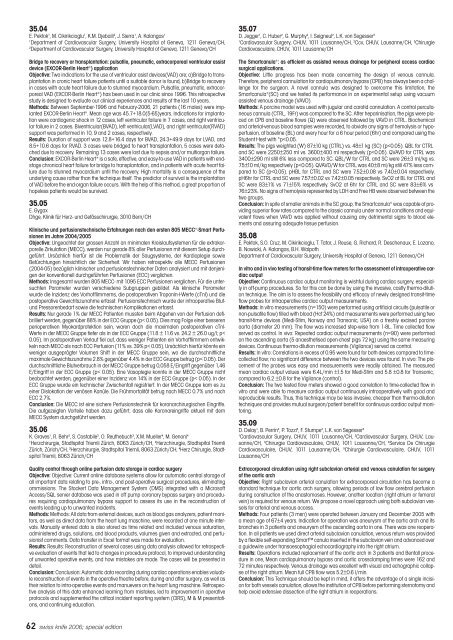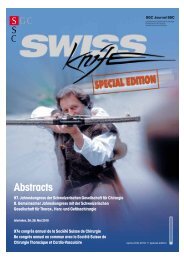Abstracts 4. Gemeinsamer Jahreskongress der ... - SWISS KNIFE
Abstracts 4. Gemeinsamer Jahreskongress der ... - SWISS KNIFE
Abstracts 4. Gemeinsamer Jahreskongress der ... - SWISS KNIFE
Create successful ePaper yourself
Turn your PDF publications into a flip-book with our unique Google optimized e-Paper software.
swissknife spezial 06 12.06.2006 13:40 Uhr Seite 62<br />
35.04<br />
E. Pektok 1 , M. Cikirikcioglu 1 , K.M. Djebaili 2 , J. Sierra 1 , A. Kalangos 1<br />
1 Department of Cardiovascular Surgery, University Hospital of Geneva, 1211 Geneva/CH,<br />
2 Depertment of Cardiovascular Surgery, University Hospital of Geneva, 1211 Geneva/CH<br />
Bridge to recovery or transplantation: pulsatile, pneumatic, extracorporeal ventricular assist<br />
device (EXCOR-Berlin Heart ® ) application<br />
Objective: Two indications for the use of ventricular asist devices(VAD) are; a)Bridge to transplantation<br />
in cronic heart failure patients until a suitable donor is found, b)Bridge to recovery<br />
in cases with acute heart failure due to stunned myocardium. Pulsatile, pneumatic, extracorporeal<br />
VAD (EXCOR-Berlin Heart ® ) has been used in our clinic since 1996. This retrospective<br />
study is designed to evaluate our clinical experiences and results of the last 10 years.<br />
Methods: Between September-1996 and February-2006, 21 patients (16 males) were implanted<br />
EXCOR-Berlin Heart ® . Mean age was 45.7+18.0(5-65)years. Indications for implantation<br />
were cardiogenic shock in 12 cases, left ventricular failure in 7 cases, and right ventricular<br />
failure in 2 cases. Biventricular(BVAD), left ventricular(LVAD), and right ventricular(RVAD)<br />
support was performed in 10, 9 and 2 cases, respectively.<br />
Results: Duration of support was 12.8+16.4 days for BVAD, 2<strong>4.</strong>3+49.9 days for LVAD, and<br />
8.5+10.6 days for RVAD. 3 cases were bridged to heart transplantation, 5 cases were detached<br />
due to recovery. Remaining 13 cases were lost due to sepsis and/or multiorgan failure.<br />
Conclusion: EXCOR-Berlin Heart ® is a safe, effective, and easy-to-use VAD in patients with endstage<br />
chronical heart failure for bridge to transplantation, and in patients with acute heart failure<br />
due to stunned myocardium until the recovery. High mortality is a consequence of the<br />
un<strong>der</strong>lying cause rather than the technique itself. The predictor of survival is the implantation<br />
of VAD before the end-organ failure occurs. With the help of this method, a great proportion of<br />
hopeless patients would be survived.<br />
35.05<br />
E. Gygax<br />
Dhge, Klinik für Herz- und Gefässchirurgie, 3010 Bern/CH<br />
Klinische und perfusionstechnische Erfahrungen nach den ersten 805 MECC ® -Smart Perfusionen<br />
im Jahre 2004/2005<br />
Objective: Ungeachtet <strong>der</strong> grossen Anzahl an minimalen Kreislaufsystemen für die extrakorporelle<br />
Zirkulation (MECC), werden nur gerade 8% aller Perfusionen mit diesem Setup durchgeführt.<br />
Ursächlich hierfür ist die Problematik <strong>der</strong> Saugsysteme, <strong>der</strong> Kardioplegie sowie<br />
Befürchtungen hinsichtlich <strong>der</strong> Sicherheit. Wir haben retrospektiv alle MECC Perfusionen<br />
(2004-05) bezüglich klinischer und perfusionstechnischer Daten analysiert und mit denjenigen<br />
<strong>der</strong> konventionell durchgeführten Perfusionen (ECC) verglichen.<br />
Methods: Insgesamt wurden 805 MECC- mit 1095 ECC Perfusionen verglichen. Für die untersuchten<br />
Parameter wurden verschiedene Subgruppen gebildet. Als klinische Parameter<br />
wurde die Inzidenz des Vorhofflimmerns, die postoperativen Troponin-I-Werte (cTnl) und die<br />
postoperative Gewichtszunahme erfasst. Perfusionstechnisch wurde <strong>der</strong> intraoperative Blutund<br />
Pressorenbedarf sowie die technischen Komplikationen erfasst.<br />
Results: Nur gerade 1% <strong>der</strong> MECC Patienten mussten beim Abgehen von <strong>der</strong> Perfusion defibrilliert<br />
werden, gegenüber 88% in <strong>der</strong> ECC Gruppe (p< 0.05). Dies mag Folge einer besseren<br />
perioperativen Myokardprotektion sein, waren doch die maximalen postoperativen cTnl-<br />
Werte in <strong>der</strong> MECC Gruppe tiefer als in <strong>der</strong> ECC Gruppe (11.8 ± 11.6 vs. 2<strong>4.</strong>2 ± 26.0 ug/l; p<<br />
0.05). Im postoperativen Verlauf fiel auf, dass weniger Patienten ein Vorhofflimmern entwikkeln<br />
nach MECC als nach ECC Perfusion (11% vs. 39% p< 0.05). Ursächlich hierfür könnte ein<br />
weniger ausgeprägter Volumen Shift in <strong>der</strong> MECC Gruppe sein, wo die durchschnittliche<br />
maximale Gewichtszunahme 2.8% gegenüber <strong>4.</strong>4% in <strong>der</strong> ECC Gruppe betrug (p< 0.05). Der<br />
durchschnittliche Blutverbrauch in <strong>der</strong> MECC Gruppe betrug 0,058 E/Eingriff gegenüber 1,46<br />
E/Eingriff in <strong>der</strong> ECC Gruppe (p< 0.05). Eine Vasoplegie konnte in <strong>der</strong> MECC Gruppe nicht<br />
beobachtet werden, gegenüber einer Inzidenz von 14% in <strong>der</strong> ECC Gruppe (p< 0.05). In <strong>der</strong><br />
ECC Gruppe wurde ein technischer Zwischenfall registriert. In <strong>der</strong> MECC Gruppe kam es zu<br />
einer Dislokation <strong>der</strong> venösen Kanüle. Die Frühmortalität betrug nach MECC 0.7% und nach<br />
ECC 2.7%.<br />
Conclusion: Die MECC ist eine sichere Perfusionstechnik für koronarchirurgischen Eingriffe.<br />
Die aufgezeigten Vorteile haben dazu geführt, dass alle Koronareingriffe aktuell mit dem<br />
MECC System durchgeführt werden.<br />
35.06<br />
K. Graves 1 , R. Behr 2 , S. Costabile 2 , O. Reuthebuch 3 , X.M. Mueller 4 , M. Genoni 4<br />
1 Herzchirurgie, Stadtspital Triemli Zürich, 8063 Zürich/CH, 2 Herzchirurgie, Stadtspital Triemli<br />
Zürich, Zürich/CH, 3 Herzchirurgie, Stadtspital Triemli, 8063 Zürich/CH, 4 Herz Chirurgie, Stadtspital<br />
Triemli, 8063 Zürich/CH<br />
Quality control through online perfusion data storage in cardiac surgery<br />
Objective: Objective: Current online database systems allow for automatic central storage of<br />
all important data relating to pre-, intra-, and post-operative surgical procedures, eliminating<br />
ommissions. The Stockert Data Management System (DMS) integrated with a Microsoft<br />
Access/SQL server database was used in off pump coronary bypass surgery and procedures<br />
requiring cardiopulmonary bypass support to assess its use in the reconstruction of<br />
events leading up to unwanted incidents.<br />
Methods: Methods: All data from external devices, such as blood gas analyzers, patient monitors,<br />
as well as direct data from the heart lung maschine, were recorded at one minute intervals.<br />
Manually entered data is also stored as time related and included venous saturation,<br />
administered drugs, solutions, and blood products, volumes given and extracted, and perfusionist<br />
comments. Data transfer in Excel format was made for evaluation.<br />
Results: Results: Reconstruction of several cases using data analysis allowed for retrospective<br />
evaluation of events that led to changes in procedure protocol, to improved un<strong>der</strong>standing<br />
of unwanted operative events, and how mistakes are made. The cases will be presented in<br />
detail.<br />
Conclusion: Conclusion: Automatic data recording during cardiac operations enables valuable<br />
reconstruction of events in the operative theatre before, during and after surgery, as well as<br />
their relation to intra-operative events and manuevers on the heart lung maschine. Retrospective<br />
analysis of this data enhanced learning from mistakes, led to improvement in operative<br />
protocols and supplemented the critical incident reporting system (CIRS), M & M presentations,<br />
and continuing education.<br />
62 swiss knife 2006; special edition<br />
35.07<br />
D. Jegger 1 , C. Huber 2 , G. Murphy 2 , I. Seigneul 2 , L.K. von Segesser 3<br />
1 Cardiovascular Surgery, CHUV, 1011 Lausanne/CH, 2 Ccv, CHUV, Lausanne/CH, 3 Chirurgie<br />
Cardiovasculaire, CHUV, 1011 Lausanne/CH<br />
The Smartcanula ® : as efficient as assisted venous drainage for peripheral access cardiac<br />
surgical applications.<br />
Objective: Little progress has been made concerning the design of venous cannula.<br />
Therefore, peripheral cannulation for cardiopulmonary bypass (CPB) has always been a challenge<br />
for the surgeon. A novel cannula was designed to overcome this limitation, the<br />
Smartcanula ® (SC) and we tested its performance in an experimental setup using vacuum<br />
assisted venous drainage (VAVD).<br />
Methods: A porcine model was used with jugular and carotid cannulation. A control percutaneous<br />
cannula (CTRL, 19Fr) was compared to the SC. After heparinisation, the pigs were placed<br />
on CPB and baseline flows (Q) were observed followed by VAVD in CTRL. Biochemical<br />
and arterial-venous blood samples were recorded, to obviate any signs of hemolysis or hypoperfusion,<br />
at baseline (BL) and every hour for a 6 hour period (6hr) and compared using the<br />
Student t-test with *p
















